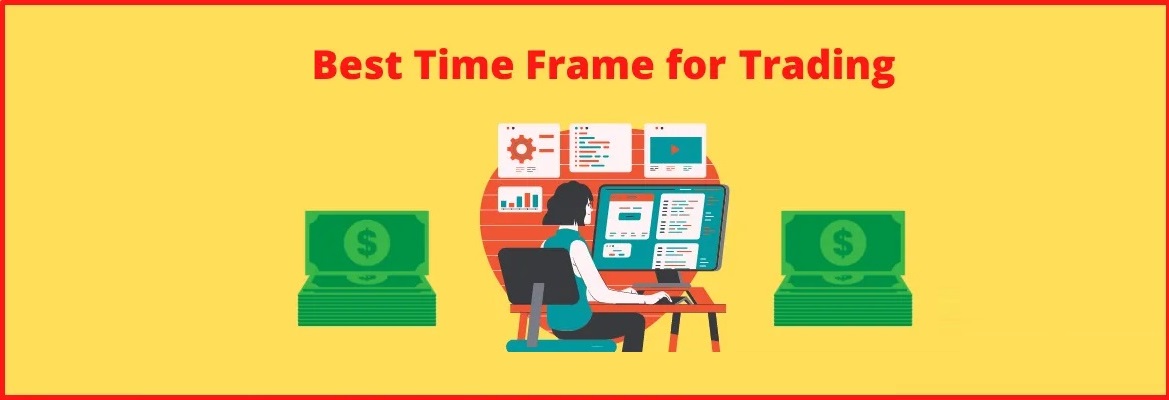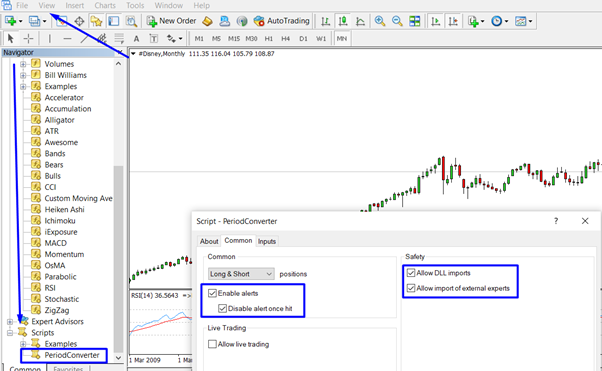What is the Best Time Frame to Trade Forex

The choice of time frame for trading is one of the problems every trader faces at the initial stage. It is necessary to grasp the subject in detail and define: what is a time frame, what are its purposes, what kinds of time frames exist, what time frame is better to trade in, and what time frame should be chosen by a beginner.
In this article, we will provide an insight into the notion of time frame, learn which one is the best for beginners, as well as will find out how to add a custom time frame.
What is a Time Frame?
A time frame is a time interval of quotes displayed on a price chart. When moving from one time frame to another, the "volume" of one candle or bar changes - the time that reflects a single bar.
In simple words, a time frame is the period of each candle or bar. For example, if you have a one-minute time frame (M1), then each candle on the chart will equal 1 minute. If you have a daily time frame (D1), then each candle will be equal to 1 calendar day.
In fact, by changing the time frame, the trader gets the opportunity to analyze the dynamics of a financial instrument in the context of the information grouping by different intervals. The importance of such analysis is the need to forecast prices for different periods, depending on a trading strategy.
How to Choose a Time Frame for Trading?
The choice of a trading period depends on several conditions, but the first and most important one is the trading strategy of a certain trader:
Scalping. Scalping is a strategy based on the fulfillment of a large number of quick transactions, the closing period of which varies from several seconds to several minutes. The strategy implies the use of the shortest timeframes: one minute (M1) and five-minute (M5).
Intraday, or action trading. The strategy, as well as scalping, foresees opening and closing positions within one trading day, but their quantity is much less. The duration of one trade varies from several minutes to several hours. Accordingly, during trading, time frames from five-minute (M5) to one-hour (H1) are used.
Medium-term strategy. This variant supposes holding trades longer - from one day to one week. Accordingly, trading periods are chosen by the adherents of this strategy, from hourly (H1) to daily (D1).
Long-term trading. The least intensive, but not the least profitable is the strategy based on the conclusion of transactions lasting, usually, at least a week. This trade is not so much trading as investing, as it is not aimed at immediate profit and allows you to forget about open positions for quite a long period. The long-term strategy traditionally uses the largest timeframes: from one day (D1) to several months (MN).
However, not everything is as obvious as it seems at first glance. The above tips are applicable, for the most part, during the direct opening of positions and making orders, as the most convenient.
It should be understood that by limiting your analysis to one or two time frames, the trader misses a lot of information for analysis. After all, the chart behaves differently at different time frames. For example, by analyzing the five-minute chart, you can detect the obvious "bullish" signals and open a long position on the instrument. However, technical analysis of an hour or half-hour timeframe, and sometimes even more senior timeframes can indicate the proximity of the instrument to the local price peak, which will be followed by a pullback.
Take a look at the one-minute time frame (M1) for Disney stock:

As you can see, the quotes move here almost sideways.
At the same time, the hourly chart (H1) already reflects clear downtrend:

But if we open the daily chart and increase the coverage a little bit, we see the following picture:

If the trader will not consider this in his forecast, the trade will, with a high probability, end up in a loss.
Which Time Frame is Better to Use for Beginners?
Often first-time traders who have no idea what time frame is better to trade for a beginner start trying various trading periods for themselves. And this principle of action is not devoid of any right to live - a trader will find the timeframe he feels comfortable trading on. A trader may choose the trading strategy according to this very principle. Even though in this case the logical sequence of actions is violated, it has one undeniable advantage: a beginner selects the strategy and the timeframe based on his own feelings, rather than based on someone's advice.
Of course, it is necessary to take into account that the time frame size is connected with the duration of a potential trade. If you plan to close a trade 15 minutes after the opening, then it does not make sense to focus on the daily chart.
It happens that beginners start randomly jumping from one-time frame to another, making hasty forecasts which in most cases end in losses and disappointment in trading. To avoid such situations, some recommendations will tell the beginner which timeframe to choose for his purposes.
First, it is necessary to determine the trading style in which the trader plans to work in the future. The basic range of working time frames should be determined depending on the duration of trades.
Then it is recommended to have several charts of different time frames displayed simultaneously on the screen, track price movement, and define (by eye, by feeling) which time frame would be more comfortable for a beginning trader making orders, and which one is the most effective for prognosis. After that, it is worth working with the chosen time frames and evaluating their convenience for the chosen strategy.
Experienced traders recommend not to dwell on one or two time frames to avoid the risk of losing large chunks of valuable information. Trading intraday does not mean that the trader should not "keep his hand on the pulse" in higher time frames. Otherwise, it can lead to periodic miscalculations in forecasts that are made without taking into account market signals at different levels.
Despite high subjectivity, many traders advise beginners to start analyzing the market in higher time frames moving gradually to lower ones. The reason is that higher time frames are less subject to chaotic fluctuations, which is very important for a trader at the beginning of his career.
Short-term time frames
When choosing which timeframe it is better to trade within the day, you should first of all pay attention to short-term time frames. The most common short-term trading periods are:
- М1. Minute;
- М5. Five-minute;
- М15. Fifteen minutes;
- М30. Half-hour.
There is also a rarely used "tick" chart that displays every change of quote in any direction. However, it is very difficult to trade on such a chart, let alone to make any forecasts because of its chaotic nature. There are strategies based on tick charts, but their development and implementation require a serious enough experience.
M1 and M5 time frames are the most effective ones for scalping as the strategy implies analysis of a chart to gain almost instant profit with the small price movements and the duration of trades does not exceed several minutes.
M1 time frame is seldom used in intraday strategy because of its rather low forecasting period that does not correspond to trade with up to several hours duration. H1 time frame is used in intraday trading, in most cases, for reference. The main trading periods for the intraday traders are М5, M15, and М30.
Medium-term time frames
The following time frames are the most frequently used in the medium-term trading strategies:
- Н1. Hour;
- Н4. Four-hour.
When forecasting price dynamics for a period of up to several days, H1 and H4 are considered to be the most informative trading periods. Charts with these time frames allow you to carry out technical analysis and identify trading signals on this interval, but they are not too detailed, allowing you to ignore the signals of small intraday fluctuations.
Long-term time frames
Long-term traders, in other words, investors, use the following trading periods when analyzing:
- D1. Daily;
- W1. Weekly;
- MN. Monthly.
In addition, there are time frames with an interval of several months, as well as the annual. However, in most cases, they are used for reference rather than for direct trading.
Which Time Frame is Better for Intraday Trading?
As we have already mentioned above, the question of choosing a time frame for intraday trading is rather subjective and depends on some factors.
All the time frames that belong to short-term ones are working periods for intraday trading. However, you should remember that when trading intraday, you should follow the market condition in general. Therefore, when trading on M5-M30 time frames it is highly recommended to check the "hourly chart" from time to time, and before you start trading - the daily chart, to avoid unpleasant surprises.
Which Time Frame to Use to Identify a Trend Reversal?
A common problem for beginners is not knowing which time frame to use to identify the trend and its reversals. However, the essence of this problem is not so much in the lack of knowledge as in an incorrect formulation of the question. After all, the most important thing in determining the trend is the interval over which it should be determined.
Nothing in trading is constant and trends are no exception. They not only change but also do not coincide at all in different time frames. Every trader knows that there are oscillations within the trend. These fluctuations often turn out to be trends in lower time frames.
For example, an uptrend on a monthly trend does not cancel the possibility of downward intraday trends.
Answering the question of which time frame to watch the trend for the beginner, the best advice is to choose the period in which it is convenient to work at the moment. If you are not comfortable holding a trade for a week, and it is interesting to close it in 3-6 hours, then work on the hourly chart. Similarly to other time frames.
How to Add Custom Time Frames to MetaTrader 4
For adding a new time frame to the terminal, we will use the "Period_Converter” function. This is the so-called time frame converter. In other words, you can add a new time frame in MetaTrader by converting other periods. For example, to add a 45-minute time frame, you can use time frames, multiple of fifteen, five, or one, that is, M1, M5, M15.
Let's consider a simple example of adding a new time frame. For example, you need an H8 time frame. To get it, we can use the standard H4, because two H4 candles will give one H8 candle. Before you start the conversion, open the chart of the pair for which you need to add the new time frame.
Click on the View menu and choose "Navigator", or just the Ctrl+N hotkey. panel and find the "General" tab there. Then switch to the "Scripts" sub-tab. Highlight it with the left mouse button, and then click the "+" icon next to it.
A drop-down list of scripts built into the terminal will appear in front of you. Select the "PeriodConverter" script among them and click the left mouse button to activate it.

After the converter is activated, we need to set its parameters. It is necessary to activate the following items in the Common tab:
- Enable alert. In the submenu that opens, also activate the item Disable once hit;
- Allow DLL imports;
- Allow import of external experts.
When all these items are checked, it is necessary to go to the "Input" category to configure the converter multiplier. The item "Period_Multiplier_Factor" is responsible for this. This number should correspond to the multiplier by which the initial time frame will be increased to get a new time frame.
However, this method has one disadvantage - the script does not always work correctly due to such a high resulting time frame. Sometimes in the process of chart rebuilding the terminal hangs and has to be restarted.
To solve this problem, traders have developed a special indicator - "P_4L_Period_Conv". In its functionality and appearance, it is very similar to the standard MT4 period converter, but in contrast to the latter, it does not freeze.
Immediately after configuring the script, the chart will automatically be rebuilt to a new time frame. The indicator does not create any restrictions in operation. You can also install any indicators, strategy templates, etc. on such a chart.
At first glance, the procedure for adding a new time frame to the terminal may seem complicated and confusing. However, in practice, this process takes no more than one minute. Thanks to the simple script, you can add any number of time frames to MetaTrader for all necessary assets.
After the custom time frame is set, you must test it on the workplace chart. Switch to the "Experts" tab, which is located at the bottom right of the terminal window. After that switch to the main menu "File" and select the command "Open Offline".
A new panel will appear on the chart listing all the available time frames. Find the necessary currency pair in time frame H8 in the list. To enable this chart, activate the necessary line by double-clicking on the left mouse button. The chart of this currency pair in the time frame H8 should instantly appear in the workspace. Next, you will only have to install and configure the necessary indicators and proceed to trade.
Please note: for the correct operation of the script, the source chart, from which the data is taken (H4) should also be open. If it is not used for searching for signals, you can simply minimize it.
Any other custom time frame can be set according to the same principle simply by changing the values of the conversion multiplier in the settings.
Let's consider some more examples:
- To set the twenty-minute time frame, you need to open the M5 chart and set the multiplier value of 4 units for it. Alternatively, open the M1 chart with a multiplier of 20;
- To add a forty-five-minute time frame, you can open the M15 chart with a multiplier of 3 or the M5 chart with a multiplier of 9. Another option is the M1 chart with a multiplier of 45;
- For the two-day chart, you can open an hour time frame with a multiplier of 48 (that is the number of hours in two days) or a daily time frame with a multiplier of 2.
There can be many such variations, depending on what time frame you want to get as a result.
Tips for Choosing the Best Time Frame
- You should not get hung up in one or two time frames. So the trader risks missing the important layers of information about the market condition.
- It is better to start trading with higher time frames for beginners moving gradually to lower time frames as they gain experience.
- When determining the trend it is necessary to decide beforehand the trend for what period is necessary to know and what is the planned duration of the position.
- When selecting the main working time frame, you should be guided primarily by the trading strategy selected. Too small a time frame will not be useful in long-term trading.
- You should not take the tick chart of the instrument price seriously.
Conclusion
The choice of the time frame depends on many factors, the main of which is the trading strategy and the trader's tactics. There is no universal trading period suitable for every market participant. That is why every beginning trader determines the time frame which is the most comfortable for him, depending on his plans and psychological qualities.









